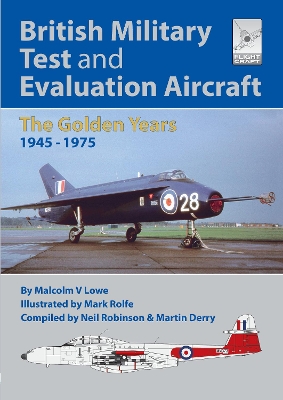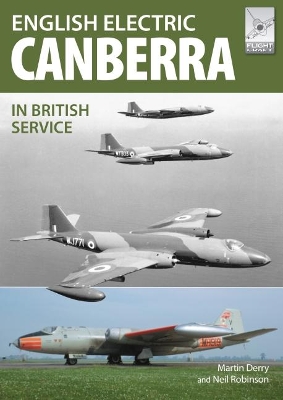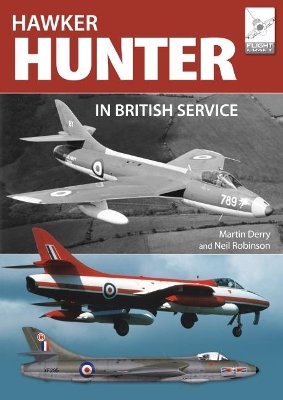Flight Craft
3 total works
Flight Craft 18: British Military Test and Evaluation Aircraft
by Robinson, Neil
Published 7 May 2019
It could be argued that the heyday of British military aircraft flight testing began in the 1940s, and continued throughout the three decades that followed, during the so-called Cold War period, and as such, the authors have purposely chosen the first 30 years, The Golden Years, 1945 to 1975, from the end of World War Two until the mid-1970s, as this was arguably the most exciting period with many wonderful and new types rubbing shoulders with wartime and immediate post-war designs that were utilised for development purposes, making for an eclectic mix of shapes and colour schemes.
Alongside the technical aspects of military testing and development, are the many and varied colour schemes and markings carried by the aircraft themselves - not only by the brand-new experimental designs, but by existing production machines, suitably modified, to greater or lesser degrees, to develop the technical advances in systems and weaponry.
Scores of different aircraft types are covered in _British Military Test & Evaluation Aircraft The Golden Years 1945 - 1975_, with over 65 rarely seen contemporary photographs from private collections, and, differing slightly from previous _Flight Craft_ book formats, over 50 pages of specially commissioned full colour profiles and plan views, visually chronicling the diverse range of colour schemes and markings applied to these fascinating aeroplanes.
Compiled by Neil Robinson and Martin Derry, who have authored several other _Flight Craft_ books, with informative background text by well known aviation historian Malcolm V Lowe and superbly executed illustrations by Mark Rolfe. As with other books in the _Flight Craft_ series, although published with aircraft modellers in mind, it is hoped that most aviation enthusiasts will find something of interest here too.
Alongside the technical aspects of military testing and development, are the many and varied colour schemes and markings carried by the aircraft themselves - not only by the brand-new experimental designs, but by existing production machines, suitably modified, to greater or lesser degrees, to develop the technical advances in systems and weaponry.
Scores of different aircraft types are covered in _British Military Test & Evaluation Aircraft The Golden Years 1945 - 1975_, with over 65 rarely seen contemporary photographs from private collections, and, differing slightly from previous _Flight Craft_ book formats, over 50 pages of specially commissioned full colour profiles and plan views, visually chronicling the diverse range of colour schemes and markings applied to these fascinating aeroplanes.
Compiled by Neil Robinson and Martin Derry, who have authored several other _Flight Craft_ books, with informative background text by well known aviation historian Malcolm V Lowe and superbly executed illustrations by Mark Rolfe. As with other books in the _Flight Craft_ series, although published with aircraft modellers in mind, it is hoped that most aviation enthusiasts will find something of interest here too.
Flight Craft 17: The English Electric Canberra in British Service
by Derry, Martin and Robinson, Neil
Published 30 November 2022
Developed by English Electric during the late 1940s - essentially as a successor to the wartime de Havilland Mosquito twin-engine, unarmed, fast bomber concept - the Canberra can lay claim to being the first British jet-powered medium bomber when it was introduced in to RAF service in May 1951\.
The Canberra became the first jet aircraft to make a non-stop transatlantic flight and amongst the performance requirements for the type was the demand for a high altitude bombing capability in addition to flying at high speeds, and in February 1951, and throughout most of the decade, the Canberra could fly at a higher altitude than any other bomber or even any other aircraft, establishing a world altitude record of 70,310ft in 1957.
The Canberra proved to be a highly adaptable airframe, and following the entry of the Vickers Valiant, the first of the trio of V Bombers in to RAF service in 1955, (see Flight Craft 7 'Valiant, Victor and Vulcan') which were capable of carrying much heavier weapon loads (including nuclear weapons) over longer ranges, the Canberra continued to serve in a variety of varied roles including tactical nuclear strike, low-level strike and ground attack in its B(I).6 and B(I).8 variants, photographic and electronic reconnaissance platform in its PR variants, multi-task training aircraft and inevitably its invaluable service with specialised MoD Test and Evaluation units.
Serving in all the RAF's Theatres of Operations including the UK, the Middle and Far East and RAF Germany, the RAF continued to operate the Canberra for 50 years from the Suez Crisis in November 1956 to its service in Afghanistan in June 2006\. The Royal Navy's Fleet Air Arm also operated Canberras, initially as radio controlled target drones and later by the Fleet Requirements Unit. Although outside the scope of this particular title, it is of interest to note that the Canberra was a significant aircraft on the export market, being operated by the air forces of many nations and was licence produced in Australia and the USA.
The Canberra became the first jet aircraft to make a non-stop transatlantic flight and amongst the performance requirements for the type was the demand for a high altitude bombing capability in addition to flying at high speeds, and in February 1951, and throughout most of the decade, the Canberra could fly at a higher altitude than any other bomber or even any other aircraft, establishing a world altitude record of 70,310ft in 1957.
The Canberra proved to be a highly adaptable airframe, and following the entry of the Vickers Valiant, the first of the trio of V Bombers in to RAF service in 1955, (see Flight Craft 7 'Valiant, Victor and Vulcan') which were capable of carrying much heavier weapon loads (including nuclear weapons) over longer ranges, the Canberra continued to serve in a variety of varied roles including tactical nuclear strike, low-level strike and ground attack in its B(I).6 and B(I).8 variants, photographic and electronic reconnaissance platform in its PR variants, multi-task training aircraft and inevitably its invaluable service with specialised MoD Test and Evaluation units.
Serving in all the RAF's Theatres of Operations including the UK, the Middle and Far East and RAF Germany, the RAF continued to operate the Canberra for 50 years from the Suez Crisis in November 1956 to its service in Afghanistan in June 2006\. The Royal Navy's Fleet Air Arm also operated Canberras, initially as radio controlled target drones and later by the Fleet Requirements Unit. Although outside the scope of this particular title, it is of interest to note that the Canberra was a significant aircraft on the export market, being operated by the air forces of many nations and was licence produced in Australia and the USA.
Flight Craft 16: The Hawker Hunter in British Service
by Derry, Martin and Robinson, Neil
Published 18 February 2019
The Hawker Hunter is one of Britain's classic post-war jet aircraft. Initially introduced in 1954 as a swept-wing, transonic, single-seat day interceptor, it rapidly succeeded the first-generation jet fighters in RAF service such as the Gloster Meteor (see Flight Craft 13) and the de Havilland Venom. Powered by the then newly developed Rolls-Royce Avon turbojet, the Hunter's performance transformed the RAF's day fighter squadrons from the mid-1950s until the advent of the English Electric Lightning from the early 1960s (see Flight Craft 11).
Even then, as successively improved variants of the type were produced with increasingly more capable engines and expanded fuel capacity, the Hunter successfully transitioned into a strike/ground attack fighter-bomber and fighter reconnaissance platform. Two-seat variants were developed for training and other secondary roles with the RAF and the Royal Navy and a few remained in use until 2001, albeit with specialised MoD Test and Evaluation units - well over forty years after the type's initial introduction. Hunters were also famously used by two RAF display teams, the 'Black Arrows', who looped a record-breaking twenty-two Hunters in formation, and later the 'Blue Diamonds' as well as the Royal Navy's 'Blue Herons'.
The Hunter saw combat service with the RAF in a range of conflicts including the Suez Crisis as well as various emergencies in the Middle East and Far East. The Hunter was also widely exported, serving with many foreign air forces, in which it also saw active service, which unfortunately lies outside the scope of this particular publication. Almost 2,000 Hunters were manufactured by Hawker Siddeley Aviation, as well as being produced under licence overseas and will remain one of the UK's most iconic aircraft designs of all time.
Even then, as successively improved variants of the type were produced with increasingly more capable engines and expanded fuel capacity, the Hunter successfully transitioned into a strike/ground attack fighter-bomber and fighter reconnaissance platform. Two-seat variants were developed for training and other secondary roles with the RAF and the Royal Navy and a few remained in use until 2001, albeit with specialised MoD Test and Evaluation units - well over forty years after the type's initial introduction. Hunters were also famously used by two RAF display teams, the 'Black Arrows', who looped a record-breaking twenty-two Hunters in formation, and later the 'Blue Diamonds' as well as the Royal Navy's 'Blue Herons'.
The Hunter saw combat service with the RAF in a range of conflicts including the Suez Crisis as well as various emergencies in the Middle East and Far East. The Hunter was also widely exported, serving with many foreign air forces, in which it also saw active service, which unfortunately lies outside the scope of this particular publication. Almost 2,000 Hunters were manufactured by Hawker Siddeley Aviation, as well as being produced under licence overseas and will remain one of the UK's most iconic aircraft designs of all time.


